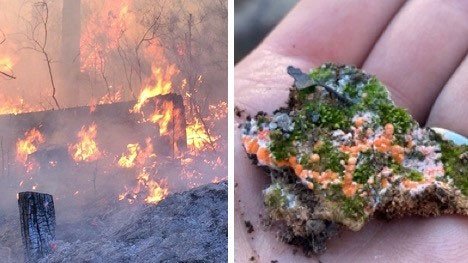10/27/2021
Fungal Recyclers: Fungi Reuse Fire-Altered Organic Matter
Degrading pyrogenic (fire-affected) organic matter is an important ecosystem function of fungi in post-fire environments.

Fire burning through a pine forest in the Sierra Nevada mountains in California (left) and the orange post-fire fungus, Pyronema domesticum, growing on burnt soil held in the palm of lead author Monika Fischer (right).
[Images courtesy Monika Fischer, University of California, Berkeley]
The Science
Wildfires can cause significant changes in the carbon found in soils. These fires can completely burn carbon away, or they can alter its chemical composition. This fire-affected carbon, called pyrolyzed organic matter (PyOM), is difficult for many organisms to use as food. Although many soil organisms are killed by wildfires, the fungus Pyronema domesticum can grow rapidly after fires. Using RNA sequencing, researchers demonstrated that this fungus thrives because it has genes associated with the degradation of a type of carbon called aromatic (ring-structured). Aromatic carbon makes up PyOM. Using a method that follows isotopes, the researchers also directly demonstrated that Pyronema can use PyOM to grow.
The Impact
These findings offer insights into the ecology of pyrophilous (fire-loving) fungi. Some fungi can grow rapidly after wildfires, changing from being barely detectable in soils to representing substantial portions of the total fungal community. This may in part be due to their ability to consume PyOM in fire-affected soils, in addition to dead microbial biomass. The recycling of PyOM by these fungi may be an important route by which carbon is recycled back into the food web after a fire.
Summary
Wildfires represent a fundamental and profound disturbance in many ecosystems, and their frequency and severity are increasing in many parts of the world. Fire affects soil by removing carbon in the form of carbon dioxide and transforming the remaining surface carbon into pyrolyzed organic matter (PyOM). Fires also generate substantial necromass (dead microbial biomass) at depths where the heat kills soil organisms but does not result in the formation of PyOM. Pyronema species strongly dominate soil fungal communities within weeks to months after a fire. However, the carbon pool (i.e., the necromass or PyOM) that fuels their rise in abundance is unknown.
In this study, researchers used a Pyronema domesticum isolate from the catastrophic 2013 Rim Fire in California to ask whether P. domesticum is capable of metabolizing PyOM. Pyronema domesticum grew readily on agar media where the sole carbon source was PyOM (specifically, pine wood PyOM produced at 750 degrees C). Using RNAseq, the researchers evaluated the response of P. domesticum to PyOM. They observed comprehensive induction of genes involved in the metabolism and mineralization of aromatic compounds, typical of those found in PyOM. Lastly, they used carbon-13 labeled 750 degree C PyOM to demonstrate that P. domesticum is capable of mineralizing PyOM to carbon dioxide. Collectively, these results indicate a robust potential for P. domesticum to liberate carbon from PyOM in post-fire ecosystems and return it to the carbon pool available to other organisms.
Principal Investigator
Matthew Traxler
Department of Plant and Microbial Biology, University of California, Berkeley
mtrax@berkeley.edu
BER Program Manager
Boris Wawrik
U.S. Department of Energy, Biological and Environmental Research (SC-33)
Biological Systems Science Division
boris.wawrik@science.doe.gov
Funding
This research was supported by the Biological and Environmental Research Program within the U.S. Department of Energy Office of Science.
References
Fischer, M.S., et al., Pyrolyzed Substrates Induce Aromatic Compound Metabolism in the Post-Fire Fungus, Pyronema domesticum. Frontiers in Microbiology 12, 728289 (2021). [DOI: https://doi.org/10.3389/fmicb.2021.729289]
